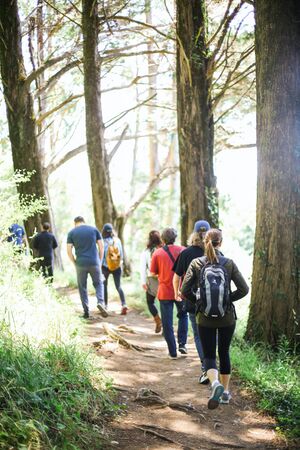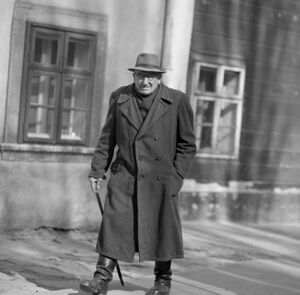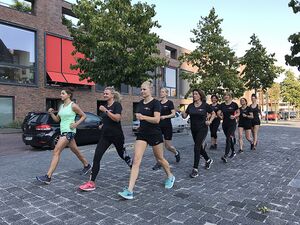Walking - Muscles Used
Original Editor - Lucinda hampton
Top Contributors - Lucinda hampton and Kim Jackson
Introduction[edit | edit source]
Walking is one of the most common modes of exercise. A walking program can be tailored to any fitness level, and being a low-impact exercise makes it appropriate for nearly every age group. A regular walking program can improve cholesterol, lower blood pressure, improve bone strength and prevent weight gain. Along with its many health benefits, walking also exercises several different muscles.[1]
- The primary muscles used in walking include the quadriceps and hamstrings, the calf muscles and the hip adductors. The gluteal and the abdominal muscles also play a significant role in forward motion.
- Gluteus maximus, gluteus medius, vasti, hamstrings, gastrocnemius, and soleus are the primary contributors to support and progression at all speeds of walking[2].
Muscles[edit | edit source]
Listed below are major muscles involved. There are more muscles that we could discuss however the key message is walking is an excellent exercise to work most of your body
Quadriceps
These muscles include the rectus femoris, vastus lateralis, vastus medialis and vastus intermedius. All four muscles work together to extend the knee while walking. The rectus femoris also acts to flex the hip, which is the movement necessary to lift your foot off the ground and prevent tripping and falls [1].
Hamstrings, Gluteals and Adductors
- The hamstring muscle group (biceps femoris, semitendinosus and semimembranosus) work together to bend the knee of the leading leg while walking.
- The gluteus maximus works with the hamstrings to extend the hip of the rear leg during a stride. Both of these muscles are worked more intensely when walking on an incline.
- The gluteus medius and minimus, located deeper in the hip, work to pull the leg sideways away from the body and help control the position of the pelvis. During walking they have an important role in keeping the pelvis stable when our body-weight is on one leg[3].
- During leg swing the sartorius, iliopsoas, tensor fasciae latae, pectineus, and adductor longus and brevis are active in controlling the leg.[4]
Lower Leg
- The tibialis anterior muscle is worked extensively while walking to lift the toes off the ground.
- The gastrocnemeus and soleus are responsible for plantar flexion (lifting the heel). They are activated on the rear foot when pushing off the ground to propel yourself forward[1].
Back Muscles
- Of the back muscles the most important ones in walking are the erector spinae muscles.
- During walking the erector spinae muscles work to control the movements of the trunk[3].
Abdomen
- Much like the back muscles, the abdominal muscles help control the movement of the trunk during motion.[3]
- Activating the core whilst walking (eg pull in the belly button) improves the posture and makes for more efficient walking. The core has been referred to as the “powerhouse” or “the engine of all limb movements.”[5]
Upper Body
- When walking, the muscles of the arms are not involved as much as the lower limb. Only the flexor muscles of the shoulders and partly the elbows are involved during the forward movement, and the extensor muscles of these joints when moving arms are moving backward.[6]The faster the stride the greater the arm swing.
- Carry small hand weights to include your upper and lower arm muscles in this efficient full-body workout[1].
Variations[edit | edit source]
Muscle contributions increase with walking speed.
- Especially large increases in the vasti (part of quadriceps) with faster speeds, during slow walking, a straighter limb in early stance (rather than muscles) provide a majority of the support against gravity.
- Soleus plays a greater role to trunk propulsion with increased speed.
- The magnitude of dorsiflexor muscle activity consistently increased with walking speed
- The hip flexors, iliopsoas and rectus femoris, make larger contributions to swing initiation and trunk propulsion with gtreater speeds[2].
An extended base of support can be assistive to vulnerable populations e.g. older adults. In wide step walking step length increases and Gluteus Minimus muscles is more active while Gracilis and Adductor Longus reduce activity. ie greater use of abductors and loss of adductor forces were found in wide step walking[7].
Physiotherapy[edit | edit source]
Physiotherapists are in an ideal position to encourage walking to clients as a way of improving health status, with low risks involved. Walking is a rhythmic, dynamic, aerobic activity of large skeletal muscles that confers the many health benefits.
- Walking, faster than customary, and regularly in sufficient quantity into the 'training zone', develops and sustains physical fitness (see principles of exercise). The increased cardiovascular capacity and endurance (stamina) for bodily work and movement in everyday life provides reserves for meeting exceptional demands.
- Muscles of the legs, limb girdle and lower trunk are strengthened and the flexibility of their cardinal joints preserved.
- Posture and carriage may improve.
- Any amount of walking, and at any pace, expends energy, so has potential for long term weight control.
- Walking enhances a multitude of bodily processes that are inherent in skeletal muscle activity, including the metabolism of high density lipoproteins and insulin/glucose dynamics.
- Walking is also the most common weight-bearing activity, and there are indications at all ages of an increase in related bone strength. [8]
Also our understanding of the muscles involved means we can analyse normal from the abnormal and work to improve the pattern of gait eg elderly- reduced stride length and reduced heel strike and toe off.
See our many gait pages.
Walking Tips
- Walk Tall. Try not to hunch while walking and keep your spine long
- Look ahead. Keeping your eyes on the path in front of you rather than looking down will reduce the pressure on your neck.
- Gentle arm swing. Your arms should swing forward and backwards like a pendulum from the shoulders as you walk.
- Walk Softly. Aim for a soft landing as you roll from the heel onto the rest of your foot[3].
Power Walking and Walking Poles (see link)
Power walking emphasizes speed and arm motion to increase your heart rate and stimulate other health benefits. It consists of pronounced arm movements and brisk, wide footsteps. Power walking is an effective way to help manage weight. Walking at a brisk pace of 6.5 km an hour it burns anywhere from 236 to 345 calories per hour depending on the level of effort.
- Power walking is an effective way to help manage weight. Since it works muscles using intense, exaggerated movement of the arms and feet, it is an efficient method for burning calories.
- Walking at a brisk pace of 6.6 km burns anywhere from 236 to 345 calories per hour depending on the level of effort.
Covid 19
The COVID 19 pandememic has changed many things. Online working has become more popular and many people are desperate to get out and about and into nature, particularly those feeling stuck in small living spaces and in cities. Walking can help people in many ways to cope:
- Physical activity releases endorphins which can help with anxiety and depression
- Being out in nature can help people to relax and be more mindful
- Walking can boost your mood and reduce stress hormones.
- Gentle walking promotes better sleep cycles and improves circulation[9]
References[edit | edit source]
- ↑ 1.0 1.1 1.2 1.3 AZ Central What muscles are used in walking Available: https://healthyliving.azcentral.com/muscles-walking-exercise-1837.html(accessed 21.12.2021)
- ↑ 2.0 2.1 Liu MQ, Anderson FC, Schwartz MH, Delp SL. Muscle contributions to support and progression over a range of walking speeds. Journal of biomechanics. 2008 Nov 14;41(15):3243-52.. Available: https://www.ncbi.nlm.nih.gov/pmc/articles/PMC4423744/(accessed 21.12.2021)
- ↑ 3.0 3.1 3.2 3.3 Heart foundation 3 muscles getting a workout while you walkAvailable: https://walking.heartfoundation.org.au/whats-on/blog/3-muscles-getting-a-workout-while-you-walk(accessed 21.12.2021)
- ↑ Livestrong Muscles involved in walking Available: https://www.livestrong.com/article/108404-muscles-walking-exercise/ (accessed23.12.2021)
- ↑ Rathore M, Trivedi S, Abraham J, Sinha MB. Anatomical correlation of core muscle activation in different yogic postures. International Journal of Yoga. 2017 May;10(2):59. Available: https://www.ncbi.nlm.nih.gov/pmc/articles/PMC5433114/(accessed 22.12.2021)
- ↑ NIKOLAI NIKONOV Mechanism of movements of muscles involved in walking Available:https://klinikanikonova.com/articles/mechanism-of-movements-of-muscles-involved-in-walking (accessed 21.12.2021)
- ↑ Bajelan S, Nagano H, Sparrow T, Begg RK. Effects of wide step walking on swing phase hip muscle forces and spatio-temporal gait parameters. In2017 39th Annual International Conference of the IEEE Engineering in Medicine and Biology Society (EMBC) 2017 Jul 11 (pp. 954-957). IEEE. Available:https://pubmed.ncbi.nlm.nih.gov/29060031/ (accessed23.12.2021)
- ↑ Morris JN, Hardman AE. Walking to health. Sports medicine. 1997 May;23(5):306-32. Available: https://pubmed.ncbi.nlm.nih.gov/9181668/(accessed 23.12.2021)
- ↑ Inheart Talk Therapy Available:https://inheart.com.au/walk-%26-talk-therapy (accessed 23.12.2021)










